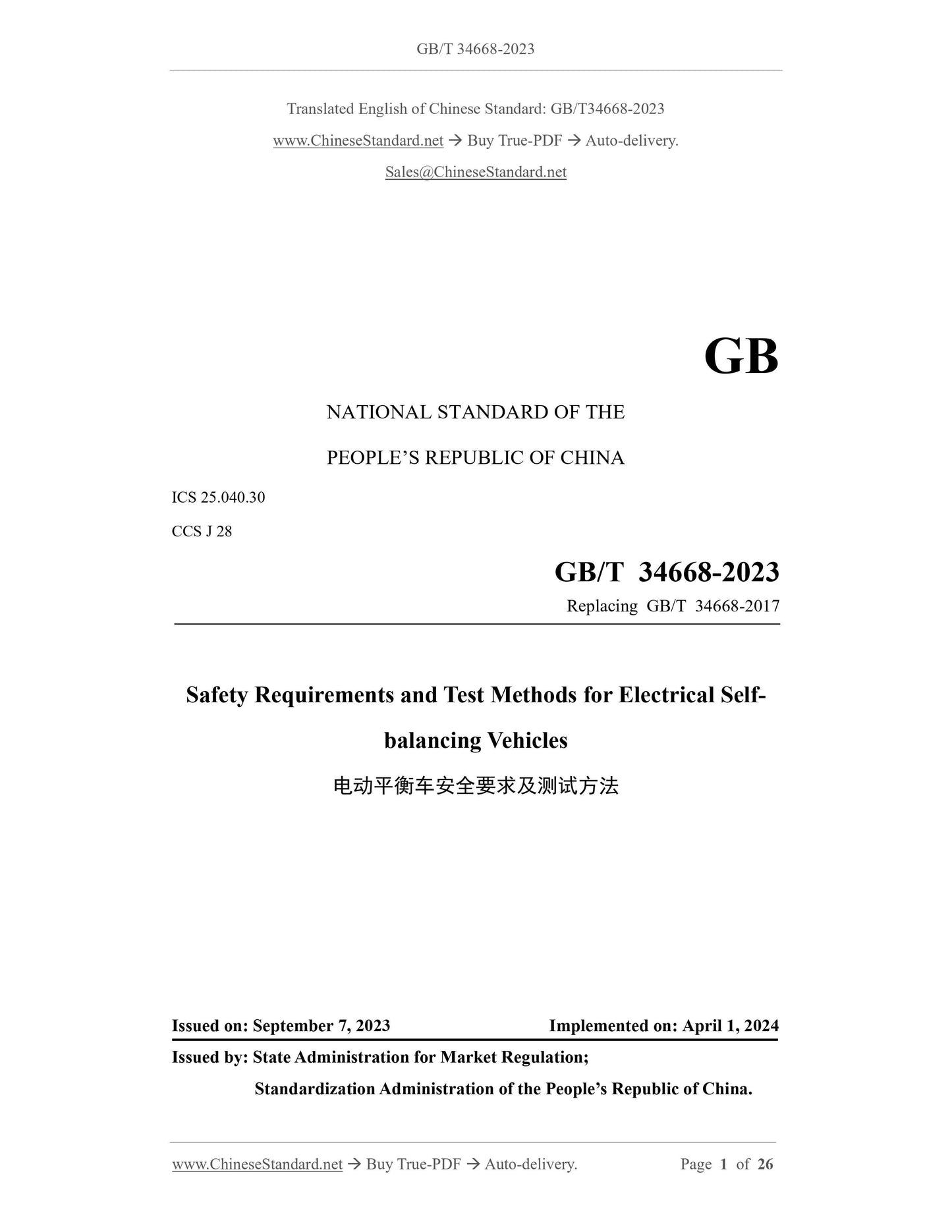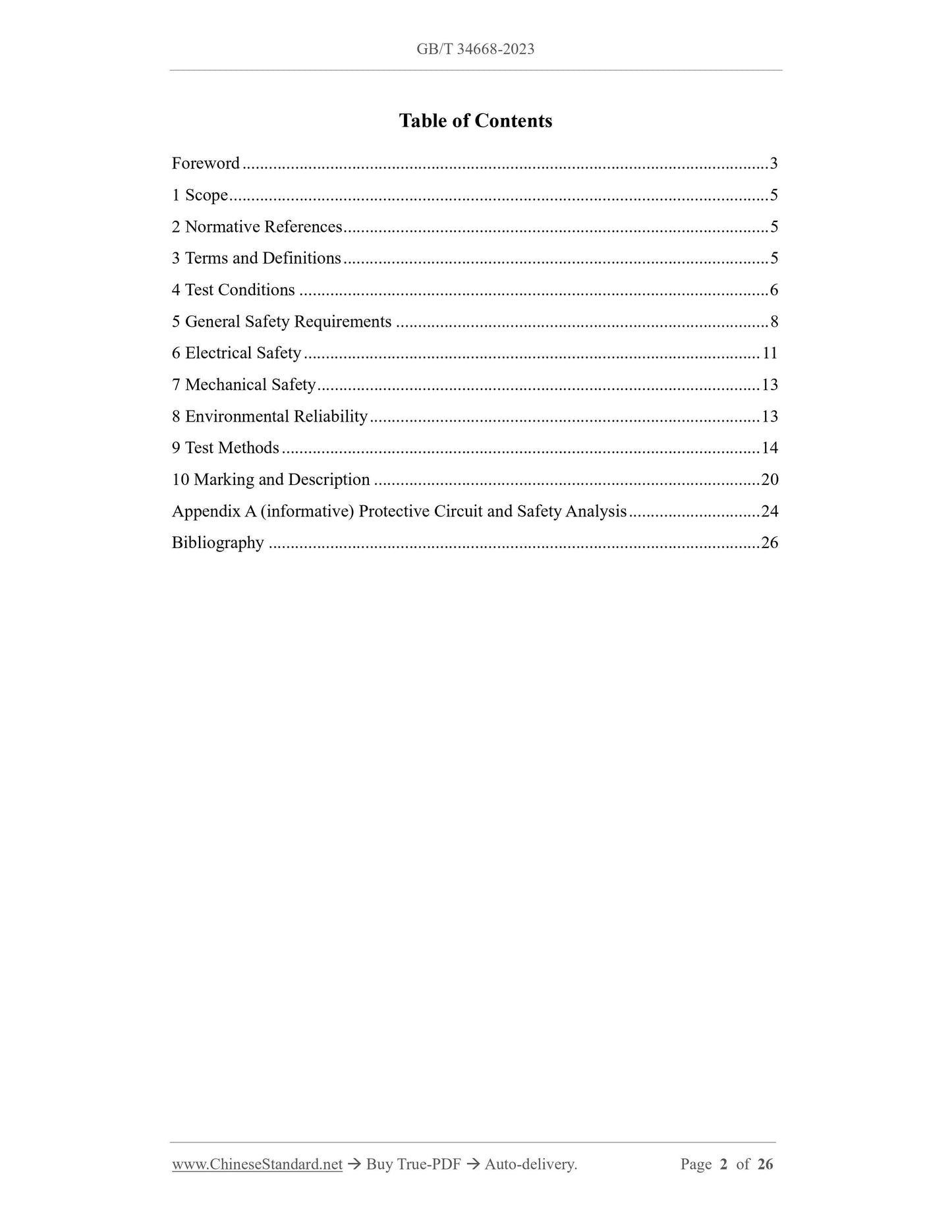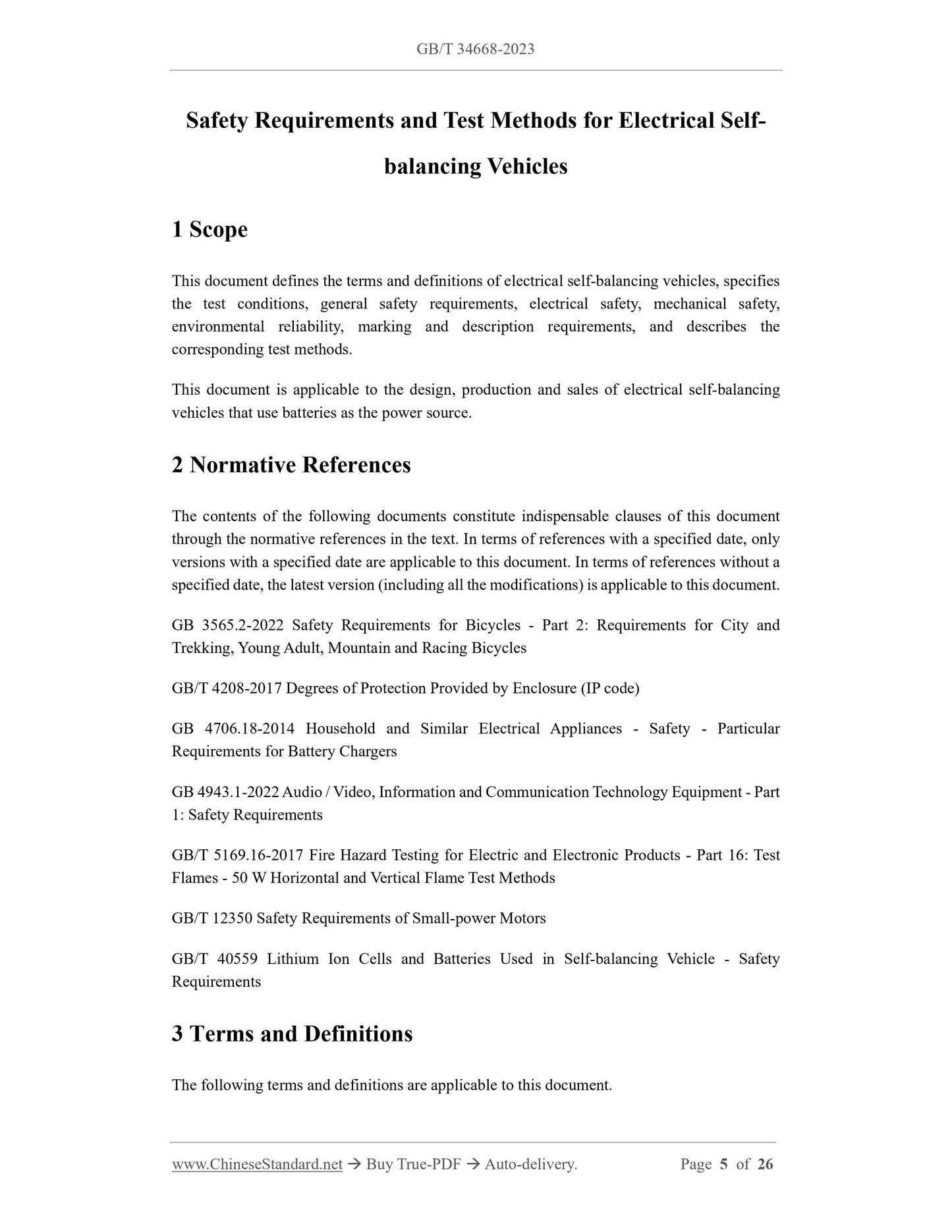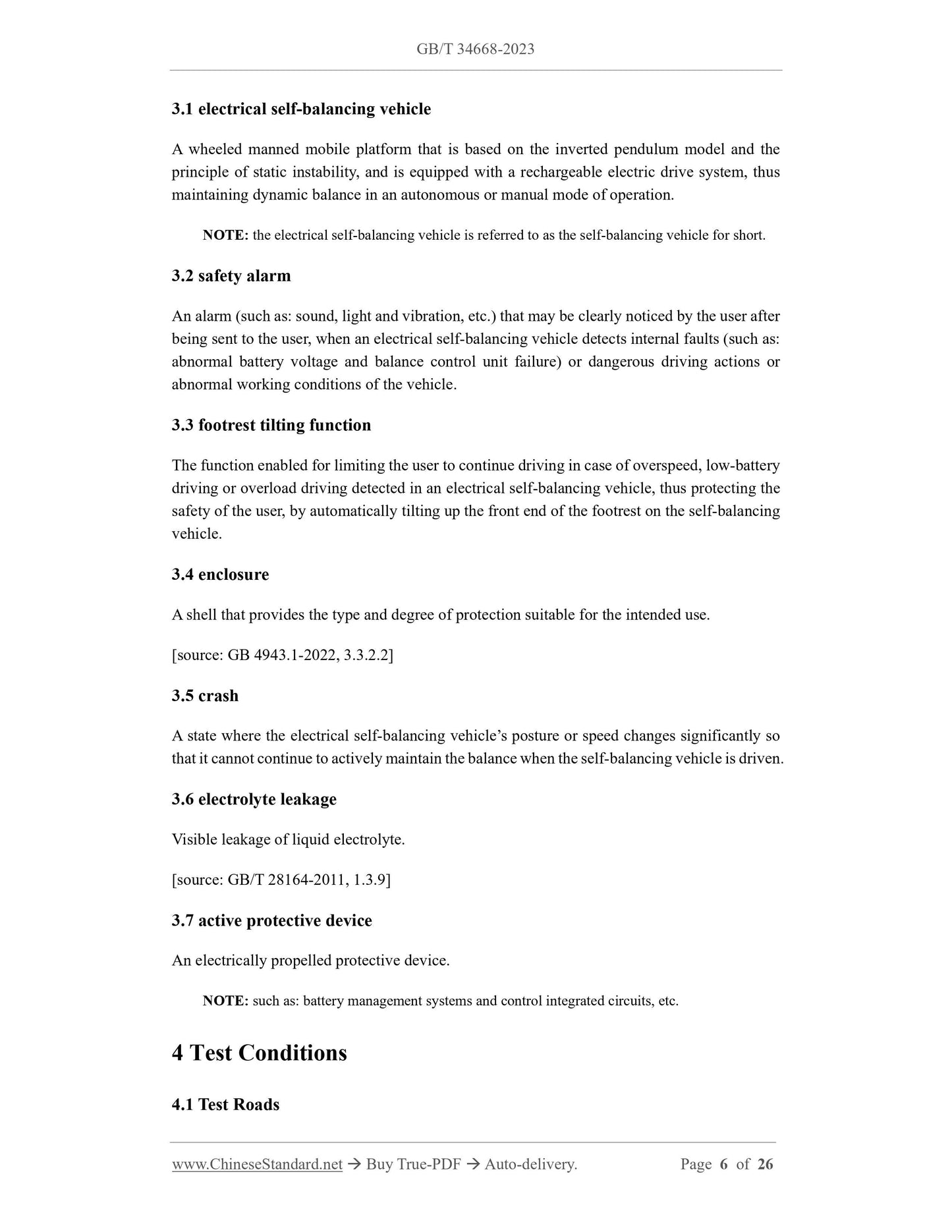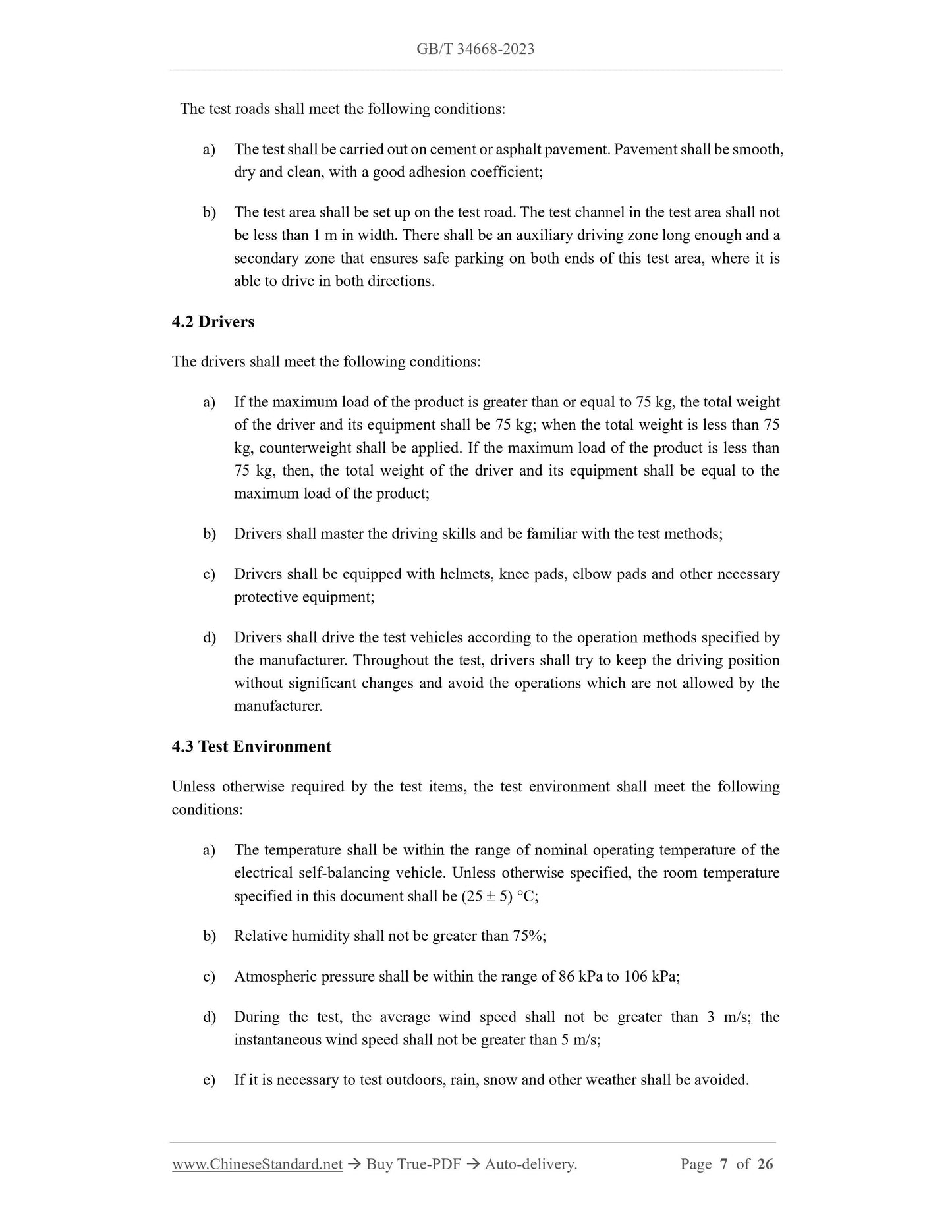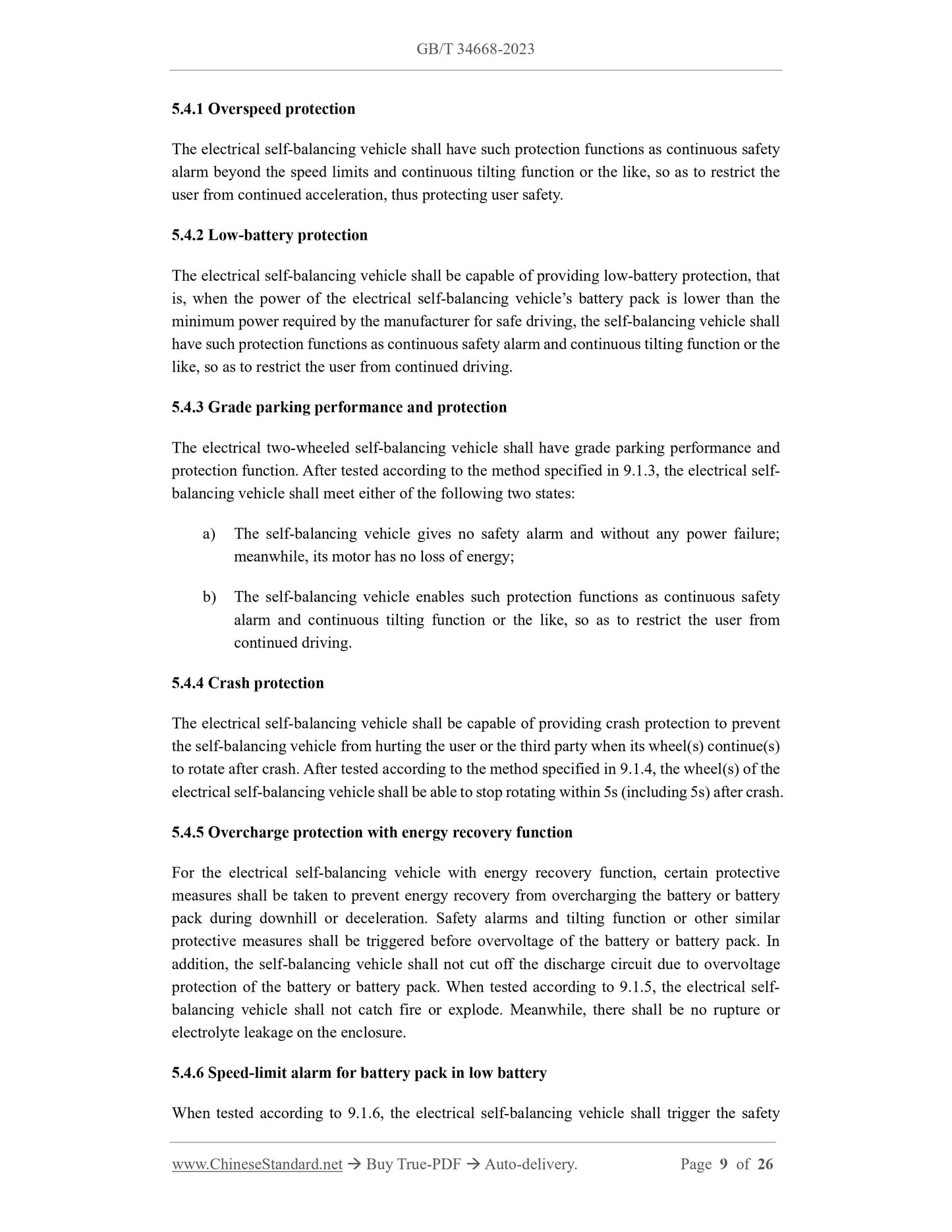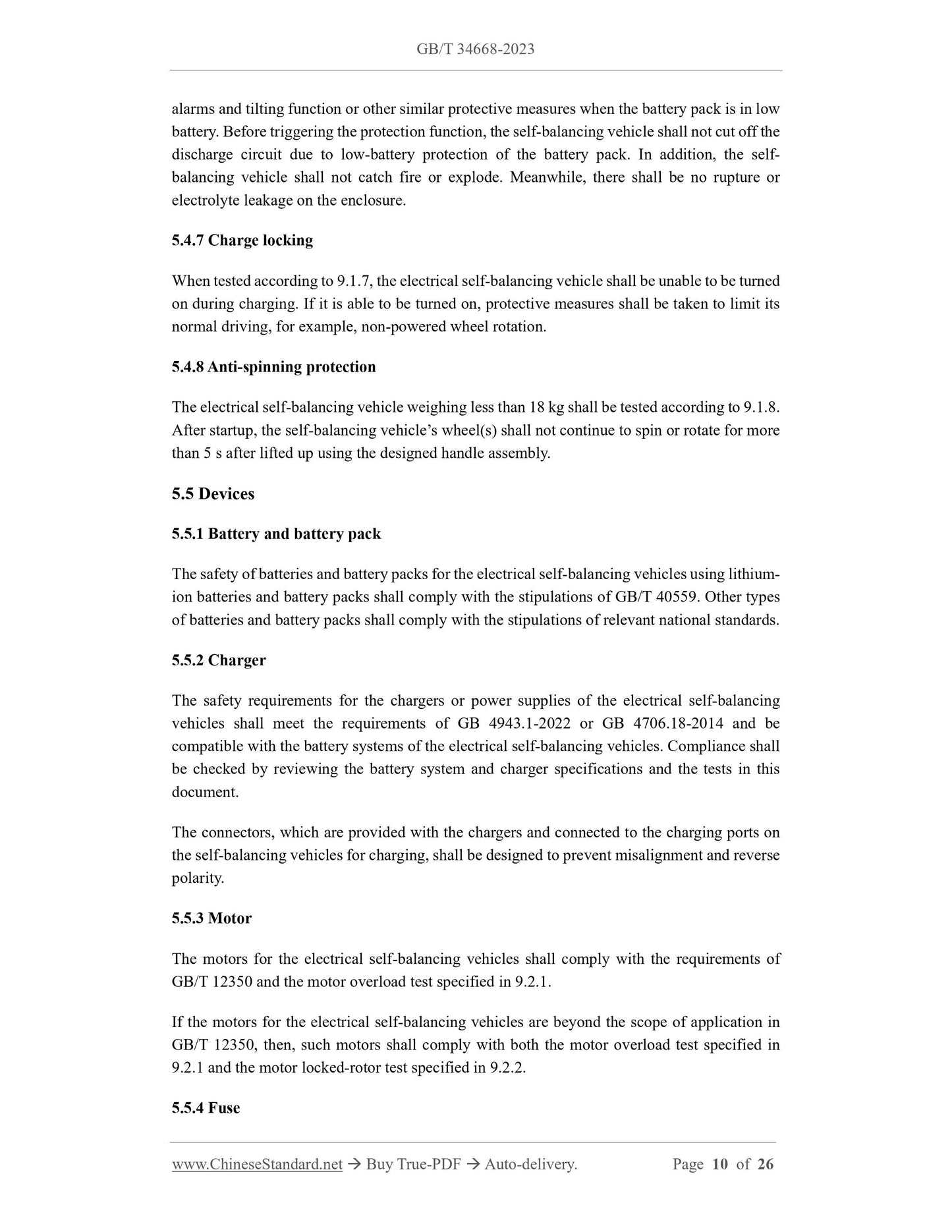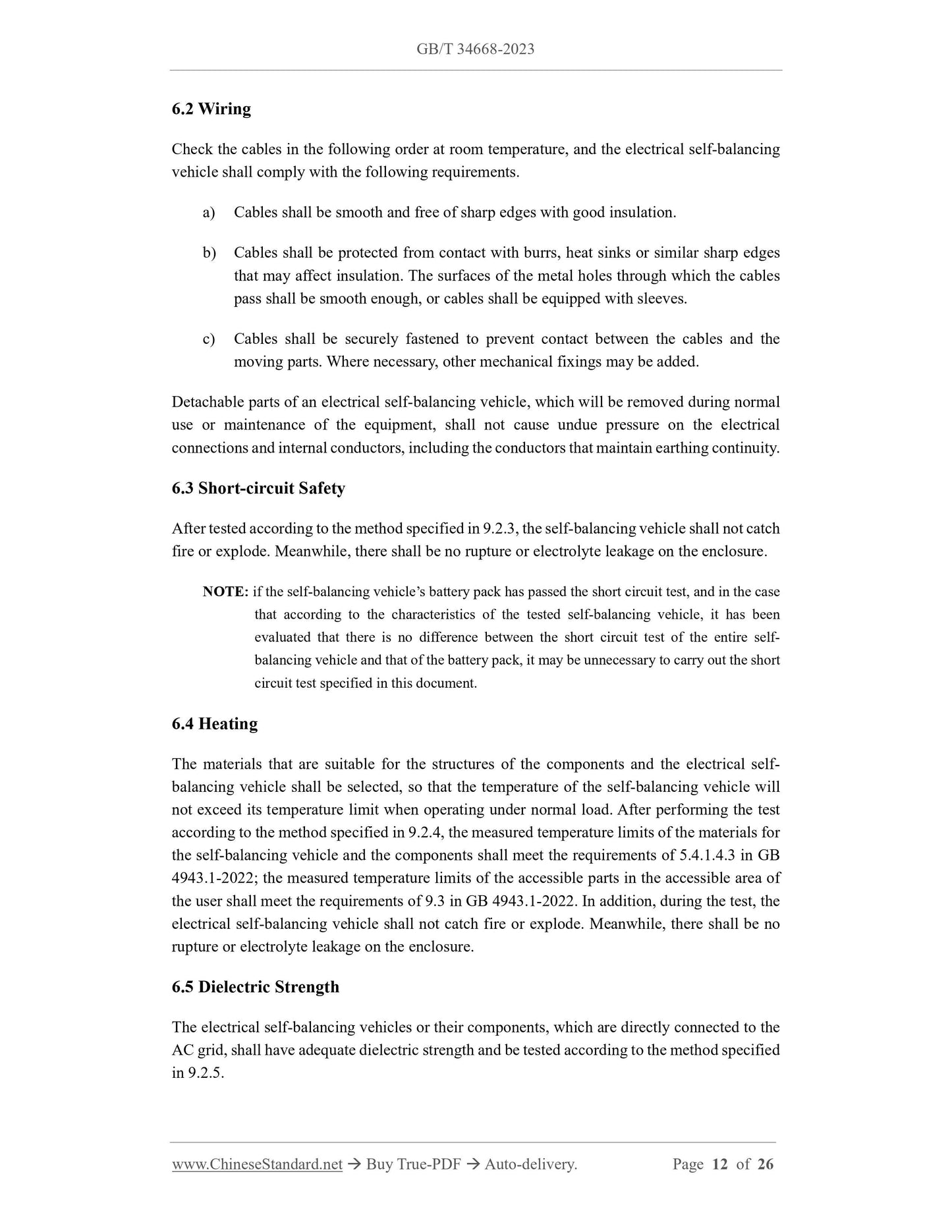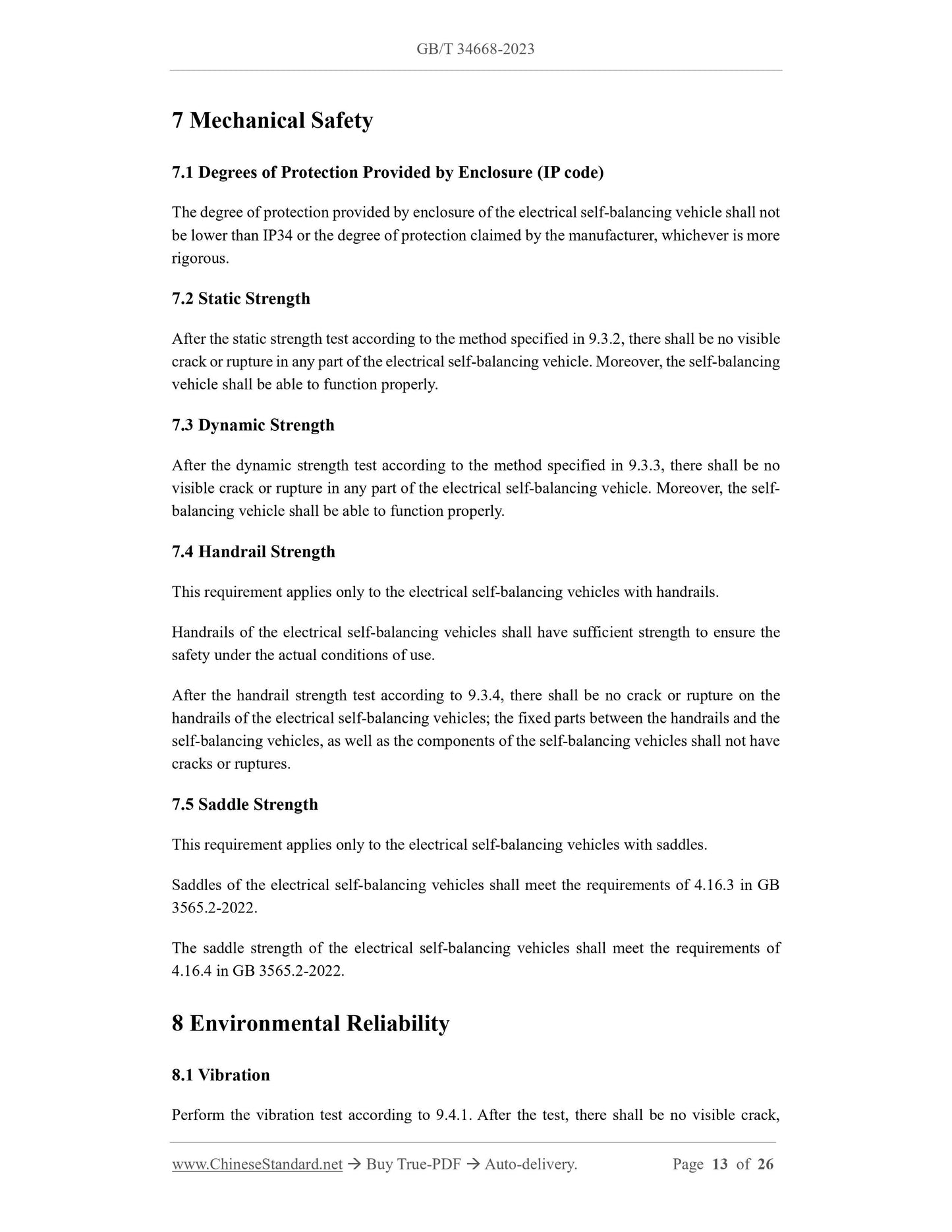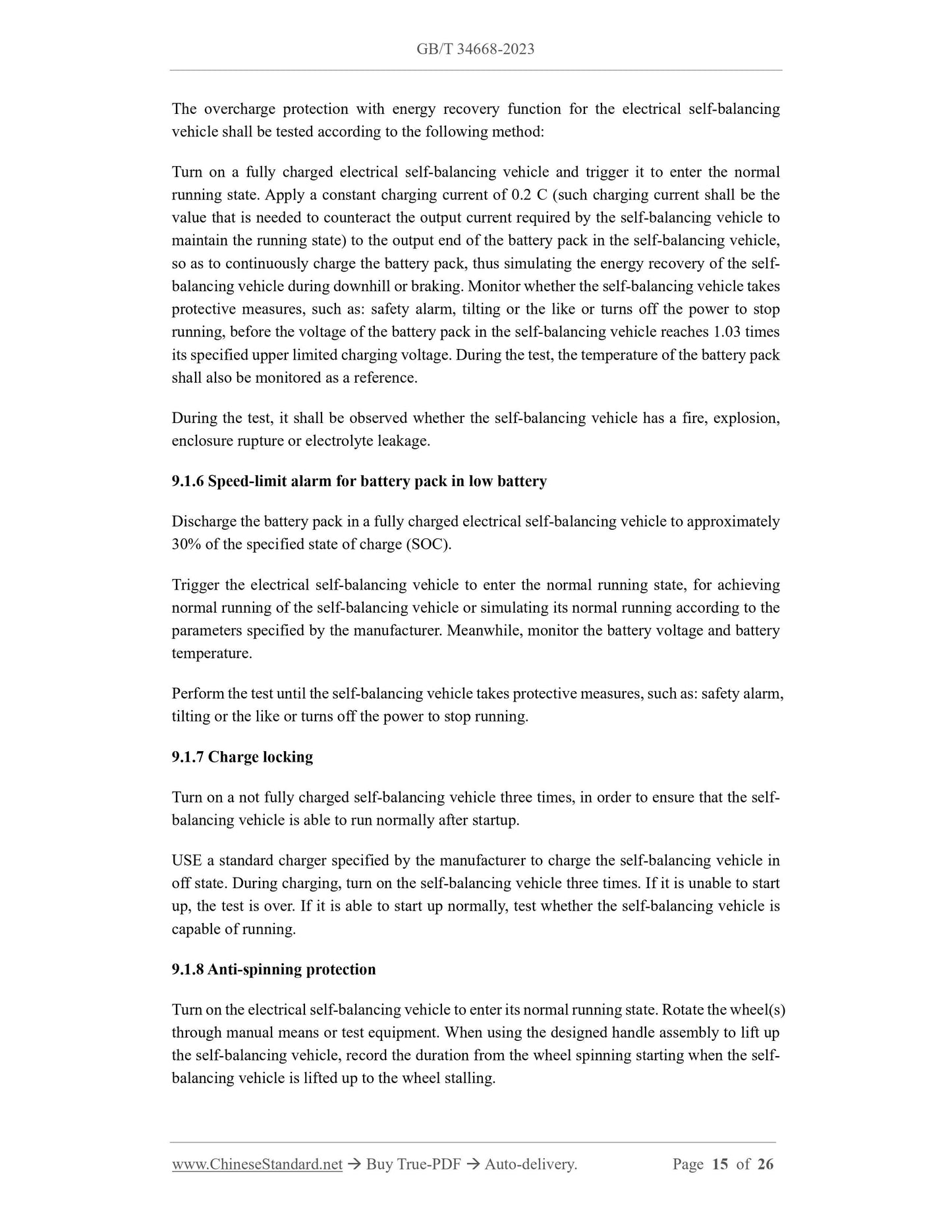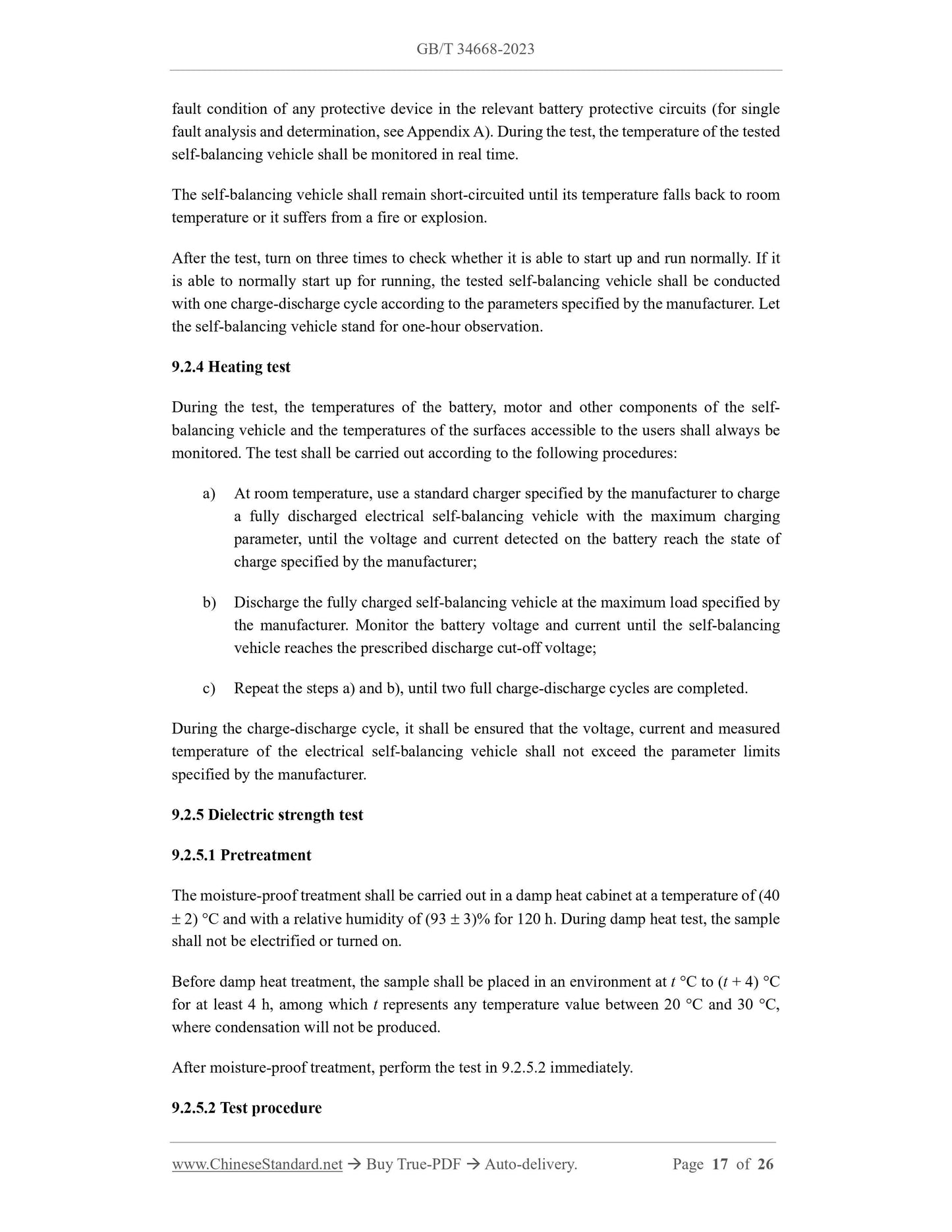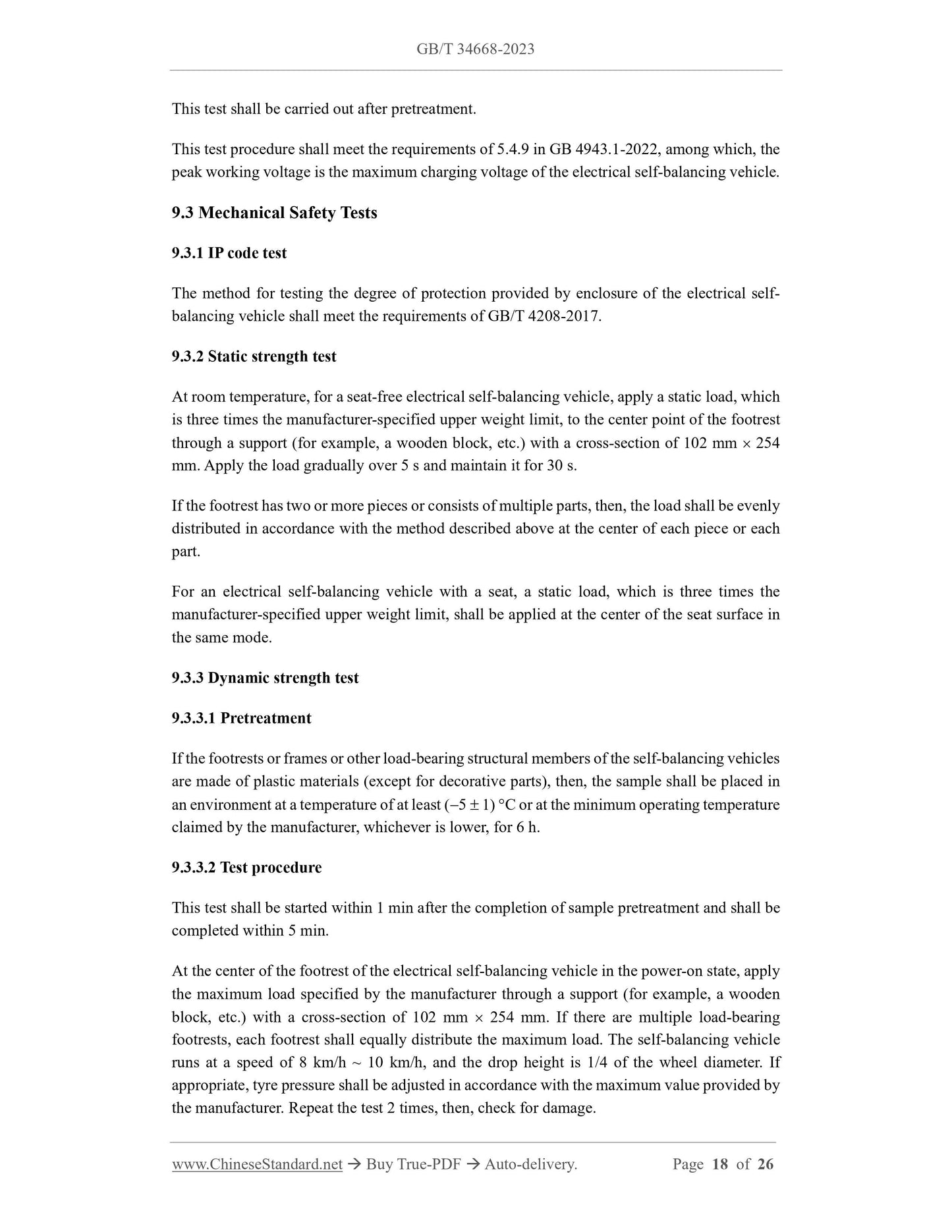1
/
of
12
PayPal, credit cards. Download editable-PDF and invoice in 1 second!
GB/T 34668-2023 English PDF (GBT34668-2023)
GB/T 34668-2023 English PDF (GBT34668-2023)
Regular price
$325.00 USD
Regular price
Sale price
$325.00 USD
Unit price
/
per
Shipping calculated at checkout.
Couldn't load pickup availability
Delivery: 3 seconds. Download true-PDF + Invoice.
Get QUOTATION in 1-minute: Click GB/T 34668-2023
Historical versions: GB/T 34668-2023
Preview True-PDF (Reload/Scroll if blank)
GB/T 34668-2023: Safety requirements and test methods for electrical self-balancing vehicles
GB/T 34668-2023
GB
NATIONAL STANDARD OF THE
PEOPLE’S REPUBLIC OF CHINA
ICS 25.040.30
CCS J 28
Replacing GB/T 34668-2017
Safety Requirements and Test Methods for Electrical Self-
balancing Vehicles
ISSUED ON: SEPTEMBER 7, 2023
IMPLEMENTED ON: APRIL 1, 2024
Issued by: State Administration for Market Regulation;
Standardization Administration of the People’s Republic of China.
Table of Contents
Foreword ... 3
1 Scope ... 5
2 Normative References ... 5
3 Terms and Definitions ... 5
4 Test Conditions ... 6
5 General Safety Requirements ... 8
6 Electrical Safety ... 11
7 Mechanical Safety ... 13
8 Environmental Reliability ... 13
9 Test Methods ... 14
10 Marking and Description ... 20
Appendix A (informative) Protective Circuit and Safety Analysis ... 24
Bibliography ... 26
Safety Requirements and Test Methods for Electrical Self-
balancing Vehicles
1 Scope
This document defines the terms and definitions of electrical self-balancing vehicles, specifies
the test conditions, general safety requirements, electrical safety, mechanical safety,
environmental reliability, marking and description requirements, and describes the
corresponding test methods.
This document is applicable to the design, production and sales of electrical self-balancing
vehicles that use batteries as the power source.
2 Normative References
The contents of the following documents constitute indispensable clauses of this document
through the normative references in the text. In terms of references with a specified date, only
versions with a specified date are applicable to this document. In terms of references without a
specified date, the latest version (including all the modifications) is applicable to this document.
GB 3565.2-2022 Safety Requirements for Bicycles - Part 2: Requirements for City and
Trekking, Young Adult, Mountain and Racing Bicycles
GB/T 4208-2017 Degrees of Protection Provided by Enclosure (IP code)
GB 4706.18-2014 Household and Similar Electrical Appliances - Safety - Particular
Requirements for Battery Chargers
GB 4943.1-2022 Audio / Video, Information and Communication Technology Equipment - Part
1: Safety Requirements
GB/T 5169.16-2017 Fire Hazard Testing for Electric and Electronic Products - Part 16: Test
Flames - 50 W Horizontal and Vertical Flame Test Methods
GB/T 12350 Safety Requirements of Small-power Motors
GB/T 40559 Lithium Ion Cells and Batteries Used in Self-balancing Vehicle - Safety
Requirements
3 Terms and Definitions
The following terms and definitions are applicable to this document.
3.1 electrical self-balancing vehicle
A wheeled manned mobile platform that is based on the inverted pendulum model and the
principle of static instability, and is equipped with a rechargeable electric drive system, thus
maintaining dynamic balance in an autonomous or manual mode of operation.
NOTE: the electrical self-balancing vehicle is referred to as the self-balancing vehicle for short.
3.2 safety alarm
An alarm (such as: sound, light and vibration, etc.) that may be clearly noticed by the user after
being sent to the user, when an electrical self-balancing vehicle detects internal faults (such as:
abnormal battery voltage and balance control unit failure) or dangerous driving actions or
abnormal working conditions of the vehicle.
3.3 footrest tilting function
The function enabled for limiting the user to continue driving in case of overspeed, low-battery
driving or overload driving detected in an electrical self-balancing vehicle, thus protecting the
safety of the user, by automatically tilting up the front end of the footrest on the self-balancing
vehicle.
3.4 enclosure
A shell that provides the type and degree of protection suitable for the intended use.
[source: GB 4943.1-2022, 3.3.2.2]
3.5 crash
A state where the electrical self-balancing vehicle’s posture or speed changes significantly so
that it cannot continue to actively maintain the balance when the self-balancing vehicle is driven.
3.6 electrolyte leakage
Visible leakage of liquid electrolyte.
[source: GB/T 28164-2011, 1.3.9]
3.7 active protective device
An electrically propelled protective device.
NOTE: such as: battery management systems and control integrated circuits, etc.
4 Test Conditions
4.1 Test Roads
The test roads shall meet the following conditions:
a) The test shall be carried out on cement or asphalt pavement. Pavement shall be smooth,
dry and clean, with a good adhesion coefficient;
b) The test area shall be set up on the test road. The test channel in the test area shall not
be less than 1 m in width. There shall be an auxiliary driving zone long enough and a
secondary zone that ensures safe parking on both ends of this test area, where it is
able to drive in both directions.
4.2 Drivers
The drivers shall meet the following conditions:
a) If the maximum load of the product is greater than or equal to 75 kg, the total weight
of the driver and its equipment shall be 75 kg; when the total weight is less than 75
kg, counterweight shall be applied. If the maximum load of the product is less than
75 kg, then, the total weight of the driver and its equipment shall be equal to the
maximum load of the product;
b) Drivers shall master the driving skills and be familiar with the test methods;
c) Drivers shall be equipped with helmets, knee pads, elbow pads and other necessary
protective equipment;
d) Drivers shall drive the test vehicles according to the operation methods specified by
the manufacturer. Throughout the test, drivers shall try to keep the driving position
without significant changes and avoid the operations which are not allowed by the
manufacturer.
4.3 Test Environment
Unless otherwise required by the test items, the test environment shall meet the following
conditions:
a) The temperature shall be within the range of nominal operating temperature of the
electrical self-balancing vehicle. Unless otherwise specified, the room temperature
specified in this document shall be (25 5) °C;
b) Relative humidity shall not be greater than 75%;
c) Atmospheric pressure shall be within the range of 86 kPa to 106 kPa;
d) During the test, the average wind speed shall not be greater than 3 m/s; the
instantaneous wind speed shall not be greater than 5 m/s;
e) If it is necessary to test outdoors, rain, snow and other weather shall be avoided.
5.4.1 Overspeed protection
The electrical self-balancing vehicle shall have such protection functions as continuous safety
alarm beyond the speed limits and continuous tilting function or the like, so as to restrict the
user from continued acceleration, thus protecting user safety.
5.4.2 Low-battery protection
The electrical self-balancing vehicle shall be capable of providing low-battery protection, that
is, when the power of the electrical self-balancing vehicle’s battery pack is lower than the
minimum power required by the manufacturer for safe driving, the self-balancing vehicle shall
have such protection functions as continuous safety alarm and continuous tilting function or the
like, so as to restrict the user from continued driving.
5.4.3 Grade parking performance and protection
The electrical two-wheeled self-balancing vehicle shall have grade parking performance and
protection function. After tested according to the method specified in 9.1.3, the electrical self-
balancing vehicle shall meet either of the following two...
Get QUOTATION in 1-minute: Click GB/T 34668-2023
Historical versions: GB/T 34668-2023
Preview True-PDF (Reload/Scroll if blank)
GB/T 34668-2023: Safety requirements and test methods for electrical self-balancing vehicles
GB/T 34668-2023
GB
NATIONAL STANDARD OF THE
PEOPLE’S REPUBLIC OF CHINA
ICS 25.040.30
CCS J 28
Replacing GB/T 34668-2017
Safety Requirements and Test Methods for Electrical Self-
balancing Vehicles
ISSUED ON: SEPTEMBER 7, 2023
IMPLEMENTED ON: APRIL 1, 2024
Issued by: State Administration for Market Regulation;
Standardization Administration of the People’s Republic of China.
Table of Contents
Foreword ... 3
1 Scope ... 5
2 Normative References ... 5
3 Terms and Definitions ... 5
4 Test Conditions ... 6
5 General Safety Requirements ... 8
6 Electrical Safety ... 11
7 Mechanical Safety ... 13
8 Environmental Reliability ... 13
9 Test Methods ... 14
10 Marking and Description ... 20
Appendix A (informative) Protective Circuit and Safety Analysis ... 24
Bibliography ... 26
Safety Requirements and Test Methods for Electrical Self-
balancing Vehicles
1 Scope
This document defines the terms and definitions of electrical self-balancing vehicles, specifies
the test conditions, general safety requirements, electrical safety, mechanical safety,
environmental reliability, marking and description requirements, and describes the
corresponding test methods.
This document is applicable to the design, production and sales of electrical self-balancing
vehicles that use batteries as the power source.
2 Normative References
The contents of the following documents constitute indispensable clauses of this document
through the normative references in the text. In terms of references with a specified date, only
versions with a specified date are applicable to this document. In terms of references without a
specified date, the latest version (including all the modifications) is applicable to this document.
GB 3565.2-2022 Safety Requirements for Bicycles - Part 2: Requirements for City and
Trekking, Young Adult, Mountain and Racing Bicycles
GB/T 4208-2017 Degrees of Protection Provided by Enclosure (IP code)
GB 4706.18-2014 Household and Similar Electrical Appliances - Safety - Particular
Requirements for Battery Chargers
GB 4943.1-2022 Audio / Video, Information and Communication Technology Equipment - Part
1: Safety Requirements
GB/T 5169.16-2017 Fire Hazard Testing for Electric and Electronic Products - Part 16: Test
Flames - 50 W Horizontal and Vertical Flame Test Methods
GB/T 12350 Safety Requirements of Small-power Motors
GB/T 40559 Lithium Ion Cells and Batteries Used in Self-balancing Vehicle - Safety
Requirements
3 Terms and Definitions
The following terms and definitions are applicable to this document.
3.1 electrical self-balancing vehicle
A wheeled manned mobile platform that is based on the inverted pendulum model and the
principle of static instability, and is equipped with a rechargeable electric drive system, thus
maintaining dynamic balance in an autonomous or manual mode of operation.
NOTE: the electrical self-balancing vehicle is referred to as the self-balancing vehicle for short.
3.2 safety alarm
An alarm (such as: sound, light and vibration, etc.) that may be clearly noticed by the user after
being sent to the user, when an electrical self-balancing vehicle detects internal faults (such as:
abnormal battery voltage and balance control unit failure) or dangerous driving actions or
abnormal working conditions of the vehicle.
3.3 footrest tilting function
The function enabled for limiting the user to continue driving in case of overspeed, low-battery
driving or overload driving detected in an electrical self-balancing vehicle, thus protecting the
safety of the user, by automatically tilting up the front end of the footrest on the self-balancing
vehicle.
3.4 enclosure
A shell that provides the type and degree of protection suitable for the intended use.
[source: GB 4943.1-2022, 3.3.2.2]
3.5 crash
A state where the electrical self-balancing vehicle’s posture or speed changes significantly so
that it cannot continue to actively maintain the balance when the self-balancing vehicle is driven.
3.6 electrolyte leakage
Visible leakage of liquid electrolyte.
[source: GB/T 28164-2011, 1.3.9]
3.7 active protective device
An electrically propelled protective device.
NOTE: such as: battery management systems and control integrated circuits, etc.
4 Test Conditions
4.1 Test Roads
The test roads shall meet the following conditions:
a) The test shall be carried out on cement or asphalt pavement. Pavement shall be smooth,
dry and clean, with a good adhesion coefficient;
b) The test area shall be set up on the test road. The test channel in the test area shall not
be less than 1 m in width. There shall be an auxiliary driving zone long enough and a
secondary zone that ensures safe parking on both ends of this test area, where it is
able to drive in both directions.
4.2 Drivers
The drivers shall meet the following conditions:
a) If the maximum load of the product is greater than or equal to 75 kg, the total weight
of the driver and its equipment shall be 75 kg; when the total weight is less than 75
kg, counterweight shall be applied. If the maximum load of the product is less than
75 kg, then, the total weight of the driver and its equipment shall be equal to the
maximum load of the product;
b) Drivers shall master the driving skills and be familiar with the test methods;
c) Drivers shall be equipped with helmets, knee pads, elbow pads and other necessary
protective equipment;
d) Drivers shall drive the test vehicles according to the operation methods specified by
the manufacturer. Throughout the test, drivers shall try to keep the driving position
without significant changes and avoid the operations which are not allowed by the
manufacturer.
4.3 Test Environment
Unless otherwise required by the test items, the test environment shall meet the following
conditions:
a) The temperature shall be within the range of nominal operating temperature of the
electrical self-balancing vehicle. Unless otherwise specified, the room temperature
specified in this document shall be (25 5) °C;
b) Relative humidity shall not be greater than 75%;
c) Atmospheric pressure shall be within the range of 86 kPa to 106 kPa;
d) During the test, the average wind speed shall not be greater than 3 m/s; the
instantaneous wind speed shall not be greater than 5 m/s;
e) If it is necessary to test outdoors, rain, snow and other weather shall be avoided.
5.4.1 Overspeed protection
The electrical self-balancing vehicle shall have such protection functions as continuous safety
alarm beyond the speed limits and continuous tilting function or the like, so as to restrict the
user from continued acceleration, thus protecting user safety.
5.4.2 Low-battery protection
The electrical self-balancing vehicle shall be capable of providing low-battery protection, that
is, when the power of the electrical self-balancing vehicle’s battery pack is lower than the
minimum power required by the manufacturer for safe driving, the self-balancing vehicle shall
have such protection functions as continuous safety alarm and continuous tilting function or the
like, so as to restrict the user from continued driving.
5.4.3 Grade parking performance and protection
The electrical two-wheeled self-balancing vehicle shall have grade parking performance and
protection function. After tested according to the method specified in 9.1.3, the electrical self-
balancing vehicle shall meet either of the following two...
Share
